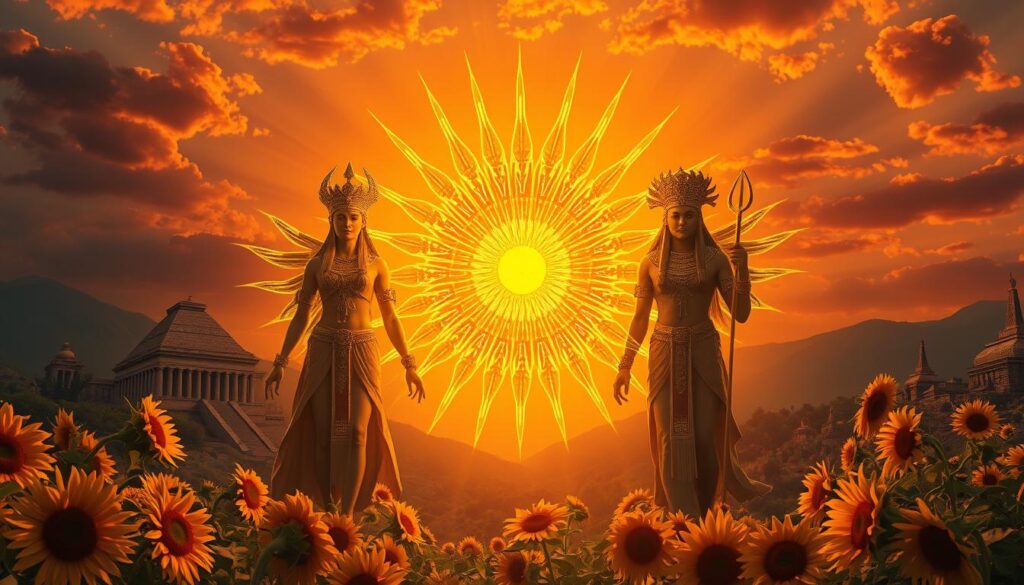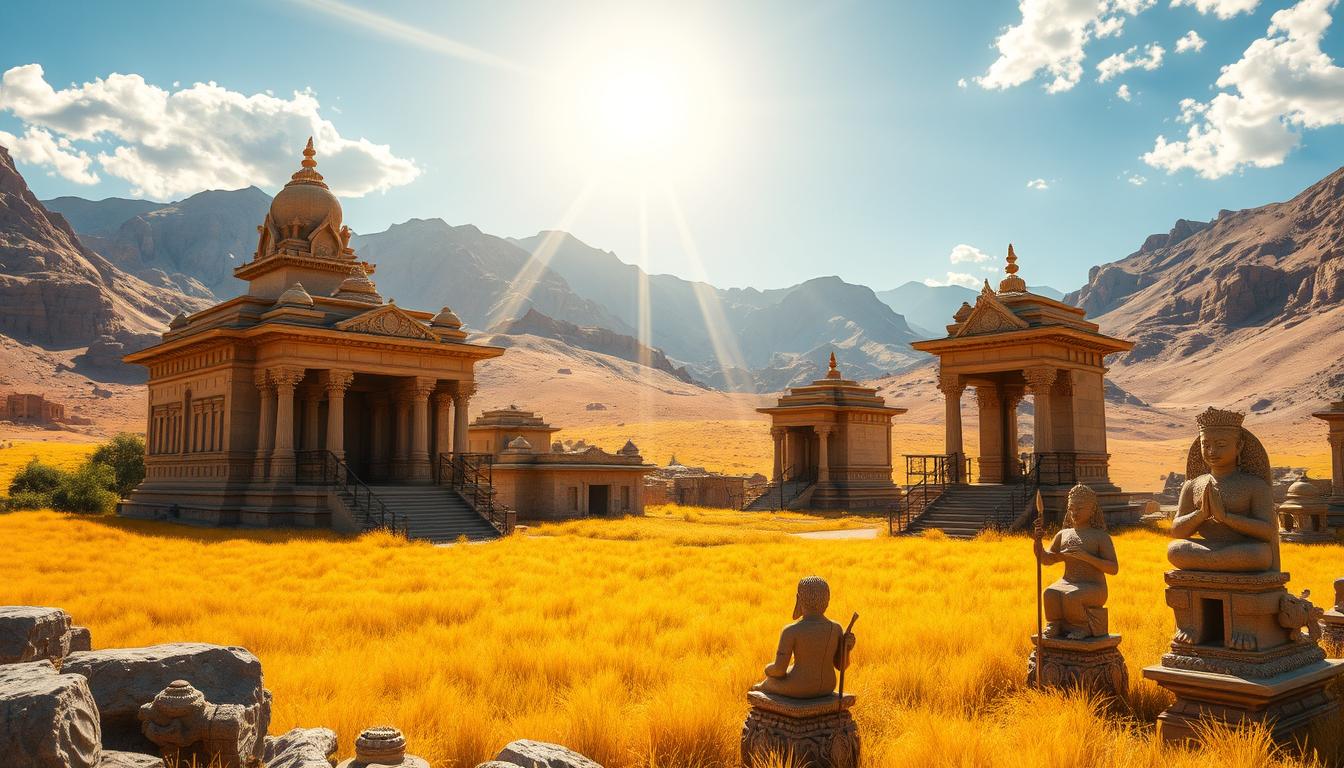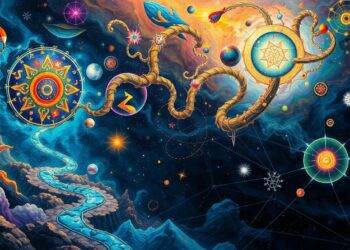“The sun, the moon, and the stars would have disappeared long ago…had they happened to be within the reach of predatory human hands.” – Henry Ellis
The sun has fascinated people for thousands of years. Ancient civilizations built grand structures like Egypt’s pyramids and Teotihuacan’s temples to honor it. Sun worship is a deep part of our cultural heritage, shaping how we see ourselves and the world.
We’ll explore the origins and growth of solar religions. We’ll see how the sun was seen as a powerful force by different cultures. From Egypt’s Ra to the Inca’s Inti, the sun was a key figure in many ancient societies.
Key Takeaways
- Discover the significant role of sun worship in ancient Egyptian, Indo-European, and Meso-American cultures.
- Explore the rich diversity of solar deities and their centrality to the belief systems of these ancient societies.
- Uncover the profound influence of solar symbolism and celestial observations on the architecture, art, and rituals of these civilizations.
- Gain a deeper understanding of how sun worship has shaped the cultural and religious legacies of the ancient world.
- Appreciate the enduring impact of this sacred tradition on modern religious and cultural practices.
Origins and Evolution of Solar Worship in Early Civilizations
For centuries, ancient cultures have been drawn to the sun’s power and beauty. They saw the sun as a divine force in their lives. This belief led to the creation of solar deities in many cultures.
These deities, like Ra in Egypt and the sun gods of the Incas and Aztecs, were central to their beliefs. People tried to understand the sun’s role in the world. They saw it as a source of life and energy.
From Monotheism to Solar Deities
Early societies often believed in one all-powerful god. But as they learned more about the world, they saw the sun’s importance. The sun’s daily cycle and warmth became key to their worship.
Figures like Ra, Helios, and Mithra became symbols of the sun. They were seen as powerful and were honored with grand rituals.
Natural Phenomena and Divine Interpretation
Events like eclipses and comets were seen as signs of the sun’s power. These events led to the development of astronomy and calendars. Leaders used this knowledge to guide their communities.
Cultural Significance of Celestial Observations
The study of the sun was vital to ancient cultures. They built monuments like Stonehenge and the pyramids to align with solar events. These structures showed their deep respect for the sun’s cycles.
| Ancient Culture | Solar Deity | Cultural Significance |
|---|---|---|
| Ancient Egypt | Ra | Ra was the ruler of the heavens and associated with the sun’s presence throughout the day, symbolizing life, power, and energy. |
| Ancient Greece | Helios | Helios, comparable to Ra, was honored annually with a dramatic ritual involving a chariot plunging off a cliff into the sea. |
| Native American Cultures | Sun Deities | The sun was recognized as a life-giving force, with traditions like the Sun Dance continuing today. |
| Mesoamerican Cultures | Sun Deities | The sun was associated with kingship, with rulers claiming divine rights through lineage to the sun. |
| Ancient Persia | Mithra | The cult of Mithra celebrated the sun’s rising daily, potentially contributing to the Christian resurrection story. |
The sun has always fascinated humans, leading to many solar-based beliefs and practices. These continue to interest scholars and the public today. Exploring solar worship shows our deep respect for the celestial forces that have shaped our history.

The Role of Sun Worship in Ancient Civilizations
Sun worship was key in many ancient cultures. It was linked with power, kindness, fairness, and wisdom. This made the sun a central figure in elite groups and the base of solar ideologies.
In ancient Egypt, the sun-god Re had at least 75 names. This shows the sun’s deep and complex role in Egyptian beliefs. Re could also merge with other gods, showing the sun’s power to unite.
“The reign of the ‘heretic’ pharaoh Akhenaten saw a radical shift towards monotheistic worship of the sun-god Aten.”
The sun’s impact wasn’t just in Egypt. The Japanese royal family comes from the Sun goddess Amaterasu. In Europe, “Sunday” shows the lasting effect of sun-worshiping cultures.
The sun was central in ancient life. It was used in sundials and in art and buildings. The Mayan pyramid at Chichen Itza in Mexico is thought to be a solar calendar. This shows how sun rituals, solar symbolism, and ancient cultures were connected.

The sun deeply influenced ancient societies. It shaped their beliefs, social structures, and views of time and the universe. The legacy of sun worship still fascinates scholars and fans today. It gives us a peek into the rich history of human civilization.
Sacred Architecture and Solar Alignments
For centuries, ancient cultures built amazing structures to honor the sun. Places like Stonehenge in the UK and the Aztec and Mayan temples in Mesoamerica show how important sun worship was to them.
Stonehenge: A Prehistoric Solar Observatory
Stonehenge, in southern England, is a key example of ancient sun worship. Built over 3,200 years ago, it aligns with the sun at solstices. It was an astronomical calendar and a place for worshiping gods.
Egyptian Pyramids and Solar Design
The ancient Egyptians loved the sun. The Great Pyramids at Giza show their knowledge of the sun’s path. Temples like Karnak also followed solar events, showing the sun’s importance in their culture.
Aztec and Mayan Solar Temples
In Mesoamerica, the Aztecs and Mayans built temples that tracked the sun. The Pyramid of the Sun in Mexico and Machu Picchu in Peru are examples. These places revered the sun as a powerful deity.
| Site | Date | Solar Alignment |
|---|---|---|
| Stonehenge | Over 3,200 years old | Aligned with the summer and winter solstices |
| Great Pyramids of Giza | Built around 2500 BC | Aligned with the cardinal points of the Earth |
| Pyramid of the Sun, Teotihuacan | Built between 1000-1200 AD | Aligned with the sun’s position |
| Machu Picchu | Built between 1450-1470 AD | Aligned with the June solstice azimuth |
These sun temples and other sacred sites worldwide show the importance of archaeoastronomy. They reveal the deep connection ancient societies had with the sun. Their work continues to fascinate scholars and visitors today.
“The sun has been a potent symbol of power, divinity, and the cycle of life for countless cultures throughout history. These remarkable architectural achievements are a testament to the deep reverence and fascination ancient societies held for the sun.”
Egyptian Sun Gods and Royal Power
In ancient Egypt, Ra was the top god among many. He was thought to have made the universe and all living things. The Egyptians saw the sun as life-giving and key to their desert farming success.
Pharaohs wore sun symbols on their crowns, showing their link to Ra. This made them seem like Ra’s earthly forms. The idea of Amon-Ra, mixing Amon with Ra, showed pharaohs’ divine right and power.
Akhenaten, a pharaoh, tried to make Aton, the sun disk, the only god. This was a big change from the usual Egyptian gods. It showed how important the sun was in their beliefs and politics.
| Key Facts about Ra and Egyptian Sun Worship |
|---|
|
The ancient Egyptian sun god Ra, also known as Re, was very important in the Nile civilization. His lasting impact still fascinates scholars and fans today. It shows how deep sun worship was in this ancient culture.
Sun Worship in Ancient Americas
The ancient Americas revered the sun deeply. They wove sun worship into their societies. From the Incan Inti Raymi to the Aztec Huitzilopochtli, they honored the sun that sustained them.
Incan Sun Festivals and Rituals
The Inca saw Inti, the sun god, as crucial. Their Inti Raymi festival celebrated the winter solstice and the sun’s renewal. It included feasting, singing, dancing, and offerings to Inti.
The site of Machu Picchu had Intihuatana stones. These stones marked the solstice and guided the Inca’s celestial observations.
Aztec Solar Mythology
The Aztecs worshipped Huitzilopochtli, a sun and war god. They believed the sun needed constant renewal. So, they performed human sacrifices to Huitzilopochtli, ensuring the sun’s daily rebirth.
This solar mythology was central to their architecture and calendars. Their temples and pyramids tracked the sun’s movements.
Sacred Solar Sites of Mesoamerica
In Mesoamerica, ancient civilizations built temples for the sun. Teotihuacan, aligned with the Pleiades, had the Pyramids of the Sun and Moon. These honored celestial deities.
Chichen Itza’s El Castillo pyramid cast a serpentine shadow during equinoxes. This showed the Mayans’ advanced solar cycle understanding.
Sun worship left a lasting legacy in ancient Americas. It shaped their beliefs, practices, and understanding of the world. From grand festivals to architectural marvels, the sun was central to their cultures.
Solar Deities in Indo-European Cultures
The sun has always been seen as a symbol of divine power in many Indo-European cultures. In India’s Vedic traditions, the sun god Surya was seen as an all-seeing deity. He watched over both good and evil actions. Sun heroes and solar kings were key figures in Indian myths, showing the sun’s importance.
In Greco-Roman mythology, Apollo was linked to the sun. He was often shown driving a chariot with four white horses. This image of solar deities in chariots was common in many Indo-European cultures. It highlighted the sun’s power and its role as a source of life and energy.
| Sun Deity | Culture | Attributes |
|---|---|---|
| Surya | Vedic India | All-seeing, observing good and evil actions |
| Apollo | Greco-Roman | Depicted driving a chariot drawn by four white horses |
Sun worship was deeply rooted in Indo-European cultures. It showed a deep respect for the sun, which brought life, warmth, and light. These solar deities were seen as symbols of divine power. Their cults and temples were important centers for religious and cultural activities.
“The sun, the moon, the stars, the seas, the hills and the plains – all these belong to me.” – Indian Proverb
Sun Symbolism and Religious Practices
The sun is deeply meaningful in ancient cultures. It’s a key symbol in many religions and spiritual practices. It’s seen as a source of life, energy, and divine power.
Solar Calendars and Sacred Times
Old civilizations made solar calendars to follow the sun’s yearly path. They marked important times like the summer and winter solstices. These were seen as the sun’s rebirth, bringing new life.
The Jewish calendar is a mix of lunar and solar cycles. It includes key events tied to the sun’s seasons.
Ritual Offerings and Ceremonies
Many ancient religions honored the sun with rituals and ceremonies. Sun Dance rituals were very important for the Plains Indians of North America. They saw the sun as a source of spiritual power.
Solar symbols were used in many religious practices. Offerings and ceremonies were made to sun gods for good harvests, victory, or divine favor.
The sun’s impact on ancient cultures is still seen today. Solstice celebrations, sun rituals, and solar symbolism shape many religions and spiritual practices worldwide.
“The sun, the moon, and the stars are all the work of the Lord’s hand. When I look at your heavens, the work of your fingers, the moon and the stars, which you have set in place, what is man that you are mindful of him, and the son of man that you care for him?” – Psalm 8:3-4
The Sun in Ancient Mythology and Literature
The sun has always been key in ancient stories and myths. It’s a symbol of life and creation across many cultures. Gods and humans alike were seen as coming from the sun’s power.
Solar deities were seen as all-knowing and wise. They stood for justice and the cycle of life and death. This cycle was seen as a never-ending journey.
Many sun gods and goddesses were celebrated for their light and healing. They were linked to truth, fertility, and new beginnings. Figures like Ra from Egypt, Surya from India, Amaterasu from Japan, and Inti from the Incas were revered in ancient texts and stories.
- In Hindu mythology, the sun god Surya travels across the sky in a chariot pulled by either seven horses or a single seven-headed horse.
- The Egyptian culture had several gods associated with different aspects of the sun, such as Khepri for the rising sun, Atum for the setting sun, and Re for the noontime sun.
- Norse mythology depicts Sol (Sunna) as the goddess of the sun, riding a chariot drawn by two golden horses, with her brother Mani as the god of the moon.
- The Shinto religion of Japan worships Amaterasu as a significant sun goddess, while her brother Tsukuyomi is the god of the moon.
- The Inca civilization revered Inti as the national patron and sun god of their state.
- The Aztecs had Huitzilopochtli as their sun god, and the Roman deity Sol Invictus was known as the unconquered sun.
- Greeks and Romans worshipped Helios (Helius) as the sun god before Apollo, who also held a position as a sun god.
These sun mythology and solar heroes have captivated us for thousands of years. They show the sun’s lasting impact in creation myths and ancient stories.
“The sun, with all those planets revolving around it and dependent on it, can still ripen a bunch of grapes as if it had nothing else in the universe to do.”
– Galileo Galilei
Archaeological Evidence of Solar Worship
Ancient civilizations revered the sun, and archaeological sites show this. Excavations have found sun temples, artifacts, and sacred objects. These discoveries reveal the sun’s importance in their beliefs and practices.
Ancient Sun Temples
In Egypt, pyramids like the one for Ra show the sun’s significance. Stonehenge in England marks celestial events. In Peru, Machu Picchu’s “Temple of the Sun” shows the Incas’ love for the sky.
The Konark Sun Temple in India is a marvel of architecture and astronomy. It shows the builders’ deep understanding of the sun.
Artifacts and Religious Objects
- On the Island of the Sun in Lake Titicaca, archaeologists found stone pillars. They were big enough to be seen against the setting sun from 15 kilometers away.
- The Island of the Sun was used for solar rituals by the Inca elite. This supported their power claims.
- At Göbekli Tepe in Turkey and Nabta Playa in Egypt, archaeologists found structures tracking the stars. This shows the ancient sun worship’s sophistication.
- Solar disks, ceremonial objects, and inscriptions in burial sites and sacred places reveal the sun’s cultural and religious importance.
The archaeological evidence of solar worship is powerful. It shows ancient cultures’ deep respect for the sun. These finds give us a glimpse into their beliefs and practices, connecting us to the sun’s timeless wonder.
| Archaeological Site | Solar Worship Evidence |
|---|---|
| Island of the Sun, Lake Titicaca | Remains of two stone pillars, possibly used in solar rituals |
| Stonehenge, England | Megalithic structure aligning with the summer and winter solstices |
| Göbekli Tepe, Turkey | Circular enclosures with T-shaped megaliths potentially marking astronomical events |
| Nabta Playa, Egypt | Stone circle tracking the summer solstice and monsoon season |
| Machu Picchu, Peru | The “Temple of the Sun” indicating Incan reverence for the celestial |
Solar Worship’s Influence on Modern Religions
The ancient sun worship has shaped many modern religions. December 25th, now Christmas, was chosen to match the Roman festival of Sol Invictus. The sun’s importance is still seen in today’s religious practices.
In Christianity, the sun’s power is deeply rooted. Scholars believe Christmas was picked to match the winter solstice. This symbolizes the sun’s “rebirth.”
Islam also uses the sun for prayer times and Ramadan. This shows the sun’s lasting impact, even in a faith that worships one God.
The sun’s legacy is seen in many symbols and festivals today. In Tibetan Buddhism, eclipses are believed to multiply merit by 100 million. In Hinduism, eclipses lead to fasting and ritual bathing. The sun’s power shapes spiritual beliefs worldwide.
“Eclipses are a reminder in Judaism that human choices can create darkness despite the existence of divine light, emphasizing the concept of free will in creating barriers between individuals and the divine.”
The sun’s symbolism is seen in Christian art, the Islamic calendar, and Hinduism and Tibetan Buddhism‘s rituals. Ancient sun worship’s influence is still strong in today’s religions.
Conclusion
Sun worship has deeply influenced human culture, shaping beliefs, societies, and buildings across the world. It shows how important the sun is to life and how it inspires us. Learning about ancient sun worship helps us understand human spirituality, science, and culture today.
The ancient Egyptians and Aztecs worshipped the sun in unique ways. Their beliefs show how the sun is seen as a powerful deity and source of life. Today, we still see the sun’s influence in festivals, buildings, and science.
Exploring sun worship reveals its lasting impact on our world view. The sun’s role in sustaining life and inspiring us is a reminder of our ancestors’ wisdom. By embracing this legacy, we can better appreciate our connection to nature and the universe.
FAQ
What was the significance of sun worship in ancient civilizations?
Sun worship was key in many ancient cultures. The sun was seen as a source of light, life, justice, and wisdom. Solar deities were seen as all-powerful and all-seeing. Kings believed they ruled by the sun’s power.
How did ancient civilizations observe and interpret celestial phenomena?
Early cultures watched the sky closely, noting events like eclipses and comets. They saw these as signs of divine power. These observations helped them create calendars and plan farming, giving leaders power and wealth.
What are some examples of ancient structures with solar alignments?
Places like Stonehenge in the UK and Egypt’s pyramids show solar alignments. Meso-American sites like Teotihuacan and Machu Picchu also highlight the sun’s importance in ancient cultures.
How was sun worship represented in ancient Egyptian mythology and beliefs?
In Egypt, the sun god Re (Ra) was a top god. The sun’s journey was seen as a myth. Pharaohs wore sun symbols on their heads, showing their divine status. Amon-Ra combined the supreme creator Amon with Ra, the sun god.
What role did sun worship play in ancient American civilizations?
Sun worship was big in ancient America. The Incas celebrated Inti Raymi, a sun festival. The Aztecs worshipped Huitzilopochtli, a sun and war god, with human sacrifices. They also had complex calendars and religious practices centered on solar deities.
How was sun worship represented in Indo-European cultures?
Indo-European peoples revered the sun as divine power. In Vedic India, Surya was an all-seeing god. Sun heroes and kings were key in Indian myths. Apollo, in Greco-Roman mythology, was the sun god, often shown with a chariot of four white horses.
How have elements of sun worship influenced modern religions?
Sun worship’s elements are seen in modern religions. December 25th, now Christmas, was once the Roman festival of Sol Invictus. Scholars link solar deities to figures like Jesus Christ. Islam uses sky observations for prayer times and Ramadan’s start.




























































